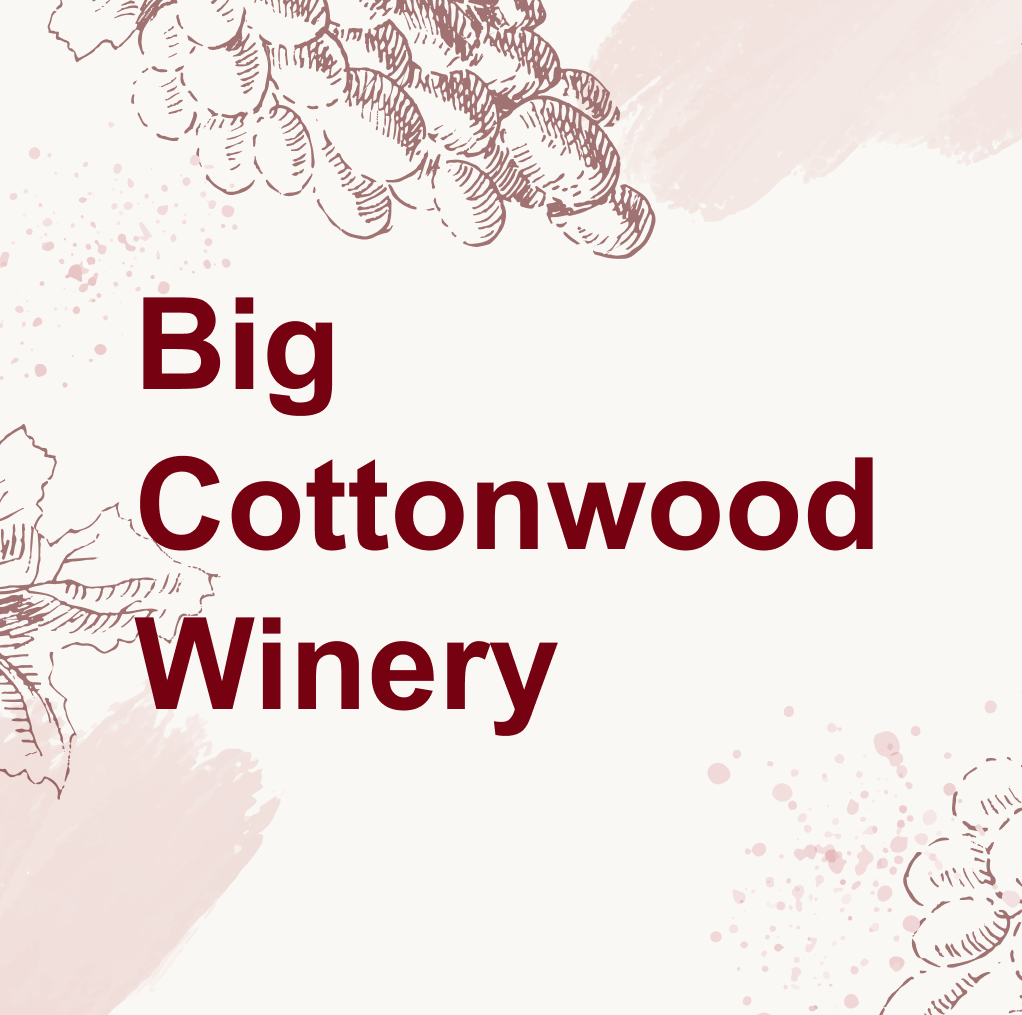The distinguishing charms and distinctive qualities of Chenin Blanc and Sauvignon Blanc have been loved by enchanted lovers of white wine. With their rich history and different taste characteristics, these two grape varieties provide a lovely experience for people’s minds and palettes.
In our article “Chenin Blanc vs. Sauvignon Blanc”, we will compare Chenin Blanc and Sauvignon Blanc in order to assist you in selecting one of these two wines.
1. Similarities of Chenin Blanc and Sauvignon Blanc
There are several similarities between Chenin Blanc and Sauvignon Blanc. Below are some characteristics that they share:
- Origin: Both wines are wonderful white wines from France. While Sauvignon Blanc is mostly connected to Bordeaux and the Loire Valley, Chenin Blanc is a Loire Valley native.
- Alcohol content and Acidity: Both of these wines have a medium body and a moderate alcohol percentage, and they are both well-balanced. The two wines also have high levels of acidity, which gives them a crisp and vibrant flavor.
- Aromatics: Both grape varieties have distinctive scents that add to their charm. Therefore, both wines have fresh, fruit-forward flavors.
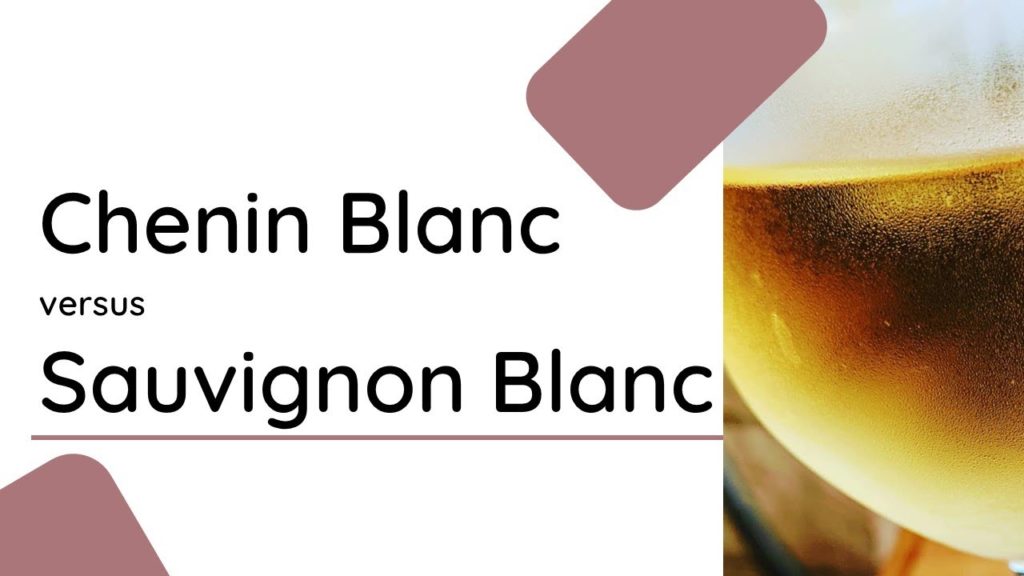
Editor’s Note: Despite these similarities, it’s crucial to remember that Chenin Blanc and Sauvignon Blanc each have distinctive qualities and flavor profiles. The final product is significantly influenced by geographical characteristics and winemaking methods.
2. Chenin Blanc vs Sauvignon Blanc: The Differences
There are major differences between the grape varieties Chenin Blanc and Sauvignon Blanc. Some of the main differences between the two are as follows:
- Flavor:
Chenin Blanc often has a larger variety of tastes than Sauvignon Blanc. It can have floral and mineral undertones as well as fruity flavors like apple, pear, quince, and honey.
Contrarily, Sauvignon Blanc is famous for its herbal and grassy scents, as well as citrus (such as lime and lemon), tropical fruits, and occasionally even a trace of bell pepper.
- Wine styles:
Both grapes are well-suited to a variety of wine styles. Chenin Blanc is capable of producing a wide range of wine styles, including sparkling wines, off-dry and sweet wines, and even botrytized dessert wines.
In contrast, Sauvignon Blanc usually comes up with dry, crisp, and fragrant white wines, though it can also be used in mixing or to make sweet wines such as Sauternes.
- Acidity (mostly about the feeling when you drink)
Both grapes have significant levels of acidity, but Sauvignon Blanc is ideal if you enjoy high-acid white wines with strong aromas. Chenin Blanc is preferable if you prefer white wines with a gentler, rounder body and more subdued fruit.
This variation may have an impact on how each grape’s wines are balanced overall and the way they feel on the tongue.
- Growing Conditions and Aging Potential
Chenin Blanc is incredibly flexible and can grow well in a wide range of temperatures, from chilly places like the Loire Valley to hotter regions like South Africa. It is also renowned for lasting well over time, particularly when produced in a more organized and intricate style. It may change and take on interesting tastes over time.
While Sauvignon Blanc traditionally thrives in warmer areas, like those that include Bordeaux, the Loire Valley, New Zealand, and parts of California, it may also be grown in milder temperatures. Furthermore, Sauvignon Blanc is often sipped while still young and crisp since the first few years following bottling are when its lively acidity and aromatic characteristics are at their best.
| Chenin Blanc |
Sauvignon Blanc |
|
| Origin | French | French |
| Aromatics | Fresh fruit scent | Fresh fruit scent |
| Flavor Profile | Floral and mineral undertones, apple, pear, honey,… | Herbal and grassy, tropical fruits, bell pepper (sometimes) |
| Wine styles | Sparkling, dry-off, sweet wines, dessert wines. | Dry wine |
| ABV | 13.5% | 12-14% |
| Food pairings | Go nicely with meals that have a sour and sweet component. | Pair nicely with dishes that are light and/or herb-heavy, like chicken, pork, fish,… |
3. Which is a better choice: Sauvignon Blanc or Chenin Blanc?
The best wine will always rely on what you like and the purpose for which it will be used.
- Base on personal taste:
Sauvignon Blanc is a good choice if you want dry white wines because it is virtually always a dry wine. Sauvignon Blanc will be a fantastic choice for you if you’re seeking tastes that are clean and crisp.
Chenin Blanc can be a better option for you if you appreciate a greater variety or a good mix of sweet and dry tastes. A deeper Chenin Blanc would be ideal if you normally favor sweet wines or are seeking a nice partner with complicated recipes.
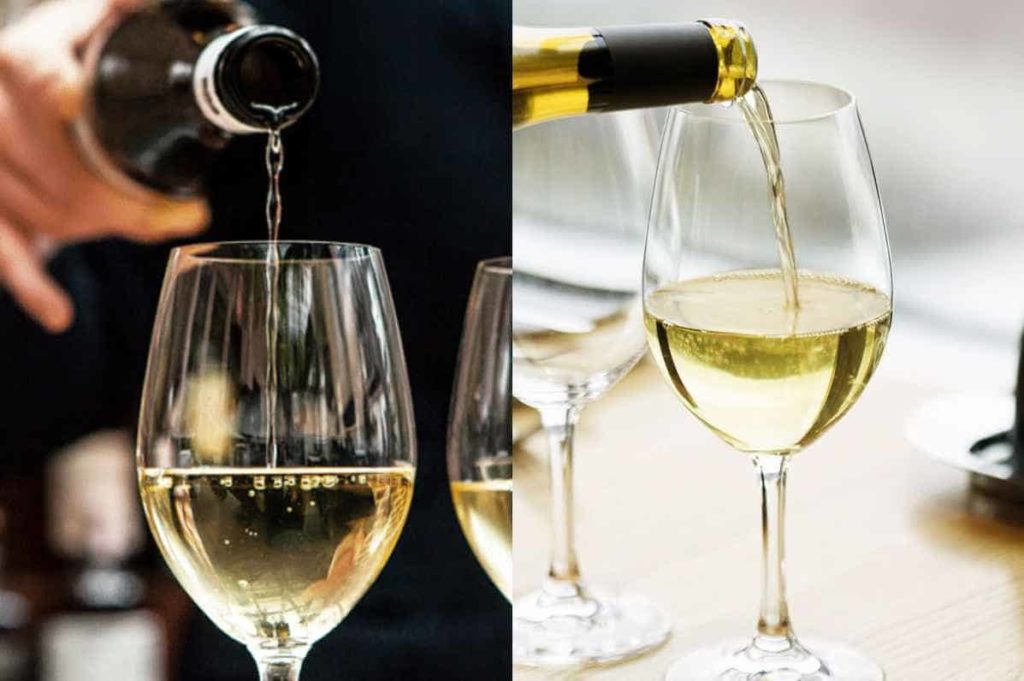
- Using in daily cooking
Sauvignon Blanc is definitely going to be your best option if you need a bottle of wine to prepare meals with but don’t want something too pricey or uncommon because it’s very inexpensive. A typical Sauvignon Blanc bottle will range between $7 and $15.
That doesn’t mean you are unable to prepare meals with Chenin Blanc, but the cost is usually a touch higher, and you could discover that Sauvignon Blanc does a more effective job of seasoning your cuisine. Also, when cooked, Chenin Blanc’s delicate flavors will be lost.
- Using in weddings or big events
Although both wines are ideal for weddings, there are a few things to keep in mind.
Sauvignon Blanc is an excellent option if your wedding will be outside on a warm day because it is lighter and crisper. Chenin Blanc is likely to be a better choice for the location whether it’s inside or at night because of its fuller body, which is suitable for more complex tastes.
Consider the menu that you will serve at your wedding as well. You should generally choose a richer Chenin Blanc if you’re cooking a hearty dish. Sauvignon Blanc is going to be ideal if there will be lighter fare, such as cheeses and fruits since its tastes go well with those kinds of dishes.
4. What is Chenin Blanc?
- Origin
Chenin Blanc is a grape that was first grown in the Anjou area of France’s Loire Valley, also known as pineau de la Loire. It is most likely a relative of the white grape savagnin from the French Jura area. Chenin white gets its name from Mont Chenin in Touraine, a wine area in the Middle Loire east of Anjou.
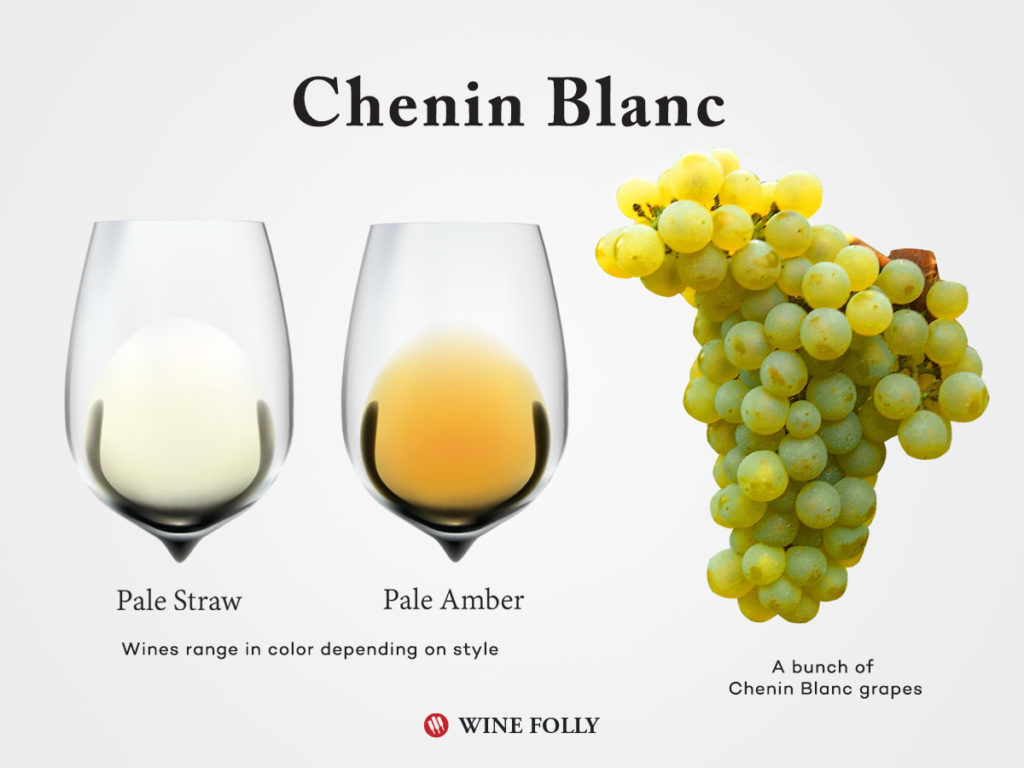
Even while Chenin Blanc is less well-known than other white grapes, it is starting to become more popular as sommeliers in locations like New York attempt to increase its popularity among wine lovers seeking sophistication and value.
- Tasting notes
The flavor of Chenin Blanc wine can differ greatly depending on the wine’s style. Dry and Off-dry are the two styles of Chenin Blanc.
Dry Chenin Blanc has a fuller body, more acidity, and scents of hay, wool, damp stone, pear, and quince.
On the other hand, Off-dry (demi-sec) varieties contain fruit smells like peach, guava, and honeysuckle that are more mature.
Late-harvest grapes are used to produce sweet Chenin Blanc wines, which feature intense flavors of honeycomb, tropical fruit, marmalade, and ginger. Noble rot can influence the grapes, imparting saffron and smoky flavors.
- ABV
The typical ABV for Chenin Blanc is 13.5%. Sometimes, though, the ABV is only 12.5%. Especially, South Africa is noted for producing the most intense Chenin Blancs, with some reaching 14.5% ABV.
This is due to the fact that it contains more body than other white wines. Additionally, because it is a flexible wine, the drier varieties have a higher alcohol percentage than the fruitier varieties.
- Food pairings
You’ll discover that Chenin Blanc goes nicely with meals that have a sour and sweet component because of its great acidity and intrinsically sweet flavor.
Additionally, it pairs beautifully with mango tarts, goat cheese, caviar, goat, pig, and grilled chicken. Sea scallops, risotto with truffles, smoked ham, pretzels, brie cheese, and sparkling Chenin Blancs for dessert go nicely together.
5. What is Sauvignon Blanc?
- Origin
Sauvignon Blanc’s original birthplace is the Loire Valley, where the word “fiers” was first documented in the 1500s. The name “Sauvignon” is a mixture of the French terms “sauvage” (meaning “wild”) and “vigne” (meaning “vine”).
Sauvignon Blanc and New Zealand are two things that many consumers pair together. California also makes a huge number of excellent Sauvignon Blancs, as well as Chile and Argentina.
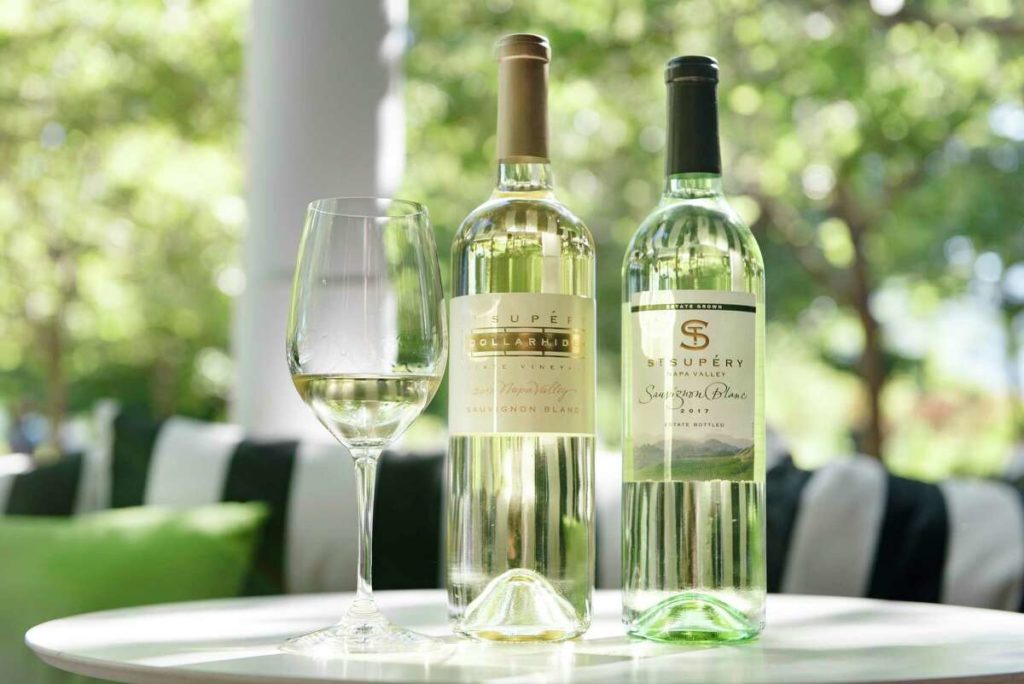
- Style
Sauvignon Blanc is often a medium-bodied dry wine and because of that, it will feel substantial yet lack sweetness. Additionally, it’s likely most recognized for its strong acidity, so don’t get too shocked when it makes your tongue pucker a little.
- Tasting notes
It tastes like fruit. Lime is the standout fruit flavor among the citrus-based primary fruit flavors, along with green apples, passion fruit, peach, and unusual gooseberry. Particularly in high-quality copies from France, scents of green bell peppers and freshly cut grass are frequently present.
- ABV
The alcohol percentage of each bottle of Sauvignon Blanc varies based on a variety of factors. The typical alcohol percentage of Sauvignon Blanc can, however, range from 12 to 14 percent by volume.
When compared to the typical alcohol percentage for wine in general, which is roughly 11.6%, it is regarded as somewhat stronger.
- Food pairings
Sauvignon Blanc pairs nicely with dishes that are light and/or herb-heavy, like chicken, pork, fish and seafood shellfish, salads, bruschetta, cheddar cheese, and vegetarian dishes.
The strong acidity in Sauvignon Blanc makes wine a superb dinner partner since acidity pulls out or amplifies tastes. The acidity of the juice from the lemon enhances the flavor of the food.
Any dish coated with herbs, such as oregano, cilantro, or rosemary, pairs well with Sauvignon Blanc’s herbaceous characteristics.
6. Tips to enjoy a glass of Chenin Blanc and Sauvignon Blanc
Wines come with a variety of suggestions that improve the flavor and fragrances. Everyone is aware that a wine’s flavor may be significantly influenced by the meal it is served with, but other factors like temperature and glasses can also improve the wine. Here are some tips for getting the most out of a glass of Chenin Blanc and Sauvignon Blanc.
Sauvignon Blanc
- Temperature:
The ideal way to enjoy Sauvignon Blanc is to serve it cold, so put it in the fridge several hours before serving. If you’re tight on time, you may also swiftly cool the wine using an ice bucket.
For optimal pleasure, serve the wine around 8°C to 10°C (46°F to 50°F). While controlling the alcohol content, this temperature range improves the taste of the wine’s brilliant acidity, herbal aromas, and fruity attributes. The flavor and fragrance of Sauvignon Blanc can be impacted by serving it at the wrong temperature.
- Glass:
The ideal glasses to serve Sauvignon Blanc are white wine glasses. Compared to red wine glasses, these glasses come with a narrower aperture, allowing them to concentrate the fragrance and flavor of the wine.
Chenin Blanc
- Temperature:
The temperature of a fridge nowadays drops to 4 degrees, and in some special refrigerators, it is even lower. But at this temperature, white wine will lose its flavor and is unable to develop its aromas.
While more robust types can handle 12 degrees, light white wines taste excellent at 10 degrees. Chenin Blanc should be served chilled at around 7–10 degrees Celcius (44–50 degrees Fahrenheit) because it is a light white wine.
- Glass:
The ideal glass to drink Chenin Blanc from is a white wine glass. In comparison to red wine glasses, white wine glasses often feature a narrower and smaller goblet. Its quirks make sure that the wine’s scents develop sweetly and are simple to detect.
See More:
- What 20 Quart Cooler Holds Ice The Longest?
-
How Long Is Prosecco Good For? (With Some Tips To Have A Fresh Prosecco)
7. Tips for pairing Chenin Blanc and Sauvignon Blanc with different foods
Chenin Blanc

- Chicken Kiev and Chenin Blanc:
The strong acidity of Chenin Blanc cuts through the fatty coating of the Chicken Kiev, keeping your tongue feeling fresh between bites. Chenin Blanc is a terrific wine combination with Chicken Kiev.
The soft chicken flavors aren’t overpowered by the medium apricot, pear, peach, and honey flavors since they’re not overly fruity or acidic.
Meanwhile, this white wine may also provide sophisticated flavors like brioche, caramel, almonds, and minerals that elevate the Chicken Kiev to a new level of delight.
- Grouper and Chenin Blanc:
Chenin Blanc is a fantastic wine to combine with grouper due to its minerality. In this situation, a dry Chenin Blanc that has aromas of chamomile flowers, apricot, apple, tropical fruit, and melon provides plenty of refreshment and is my preferred pairing for grouper.
Grouper that is boiled or grilled and served simply has a light flavor, so a vibrant but not overpowering wine adds enough interest to keep you hooked on your dinner.
The creamy texture of the sauce will be enhanced by a little oaked Chenin Blanc if you plan to serve Grouper with it. The flavors of vanilla, brioche, and caramel will come through in an oaked Chenin Blanc, making the pairing of wine and food particularly tasty.
Sauvignon Blanc:

- Guacamole and Sauvignon Blanc:
The flavors of the fresh, creamy guacamole will truly show out when Sauvignon Blanc is added to the mixture.
Because avocados are naturally fatty, the sharpness of Sauvignon Blanc helps it to wash easily off your taste buds, enhancing the freshness of every mouthful of food you are eating, like corn chips, tacos, and burritos. In addition to keeping your tongue free of any salt or grain that may have joined your guacamole, the sharp and citrus flavors of Sauvignon Blanc can also help you enjoy your great cuisine.
- Herbed Lemon Chicken and Sauvignon Blanc:
Highly acidic white wine such as Sauvignon Blanc is a great match for chicken since it will enhance the delicate poultry flavors in your chicken. Chicken is simple to overcook, but the crisp flavors of Sauvignon Blanc readily cover up any dryness, providing for a better dish. Any herbs thrown into your chicken recipe will be complemented by the aromatic and green flavors of Sauvignon Blanc.
Therefore, if you are eating properly, a nice sip of Sauvignon Blanc may make the food taste more fascinating and give you more motivation to enjoy straightforward meals like this more frequently.
9. FAQs
Is Sauvignon Blanc’s acidity higher than Chenin Blanc’s?
Although Chenin Blanc has a somewhat tarter and more acidic flavor than Sauvignon Blanc, many consumers favor the latter’s herbaceous and energizing character. Some people appreciate the deeper body and rounder mouthfeel of a decent Chenin Blanc, while others find it to be overly dry or acidic.
Do you need to refrigerate Chenin Blanc wine?
Chenin Blanc, both sparkling and dry non-sparkling, is best served cold, however, the wine will evolve as part of the chill wanes in the glass. Sweeter varieties are best savored chilly but not too cold so that their honeyed and occasionally earthy and floral undertones may completely show themselves.
Can you use Sauvignon Blanc in your cooking?
This wine varietal has a racier flavor compared to other white wines and tastes zesty and herbaceous. Sauvignon Blanc is among the most ideal white wines to pair with chicken, shellfish, and other rich and creamy foods because of its acidity.
What causes the acidity in Sauvignon Blanc?
The UV rays aid in the ripening of the grapes, and because they are powerful, they allow the grapes to ripen while it is still relatively chilly, preserving their fresh acidity. Most other wine areas require relatively warm temperatures to ripen and taste the grapes, and this warmth can also lessen acidity.
Are tannin levels in Chenin Blanc high?
The body ranges from crisp in sparkling wines to extra rich in dessert wines made with Chenin Blanc. Chenin Blanc has a low tannin content, like the majority of white wine grapes.
In what ways should you serve Sauvignon Blanc?
Sauvignon Blanc should be drunk cold, like other white wines. It will reach the appropriate temperature range of 50–55 degrees Fahrenheit after about two hours in the fridge. An ice bucket for 30 to 40 minutes can do the trick for quicker results or outdoor activities.
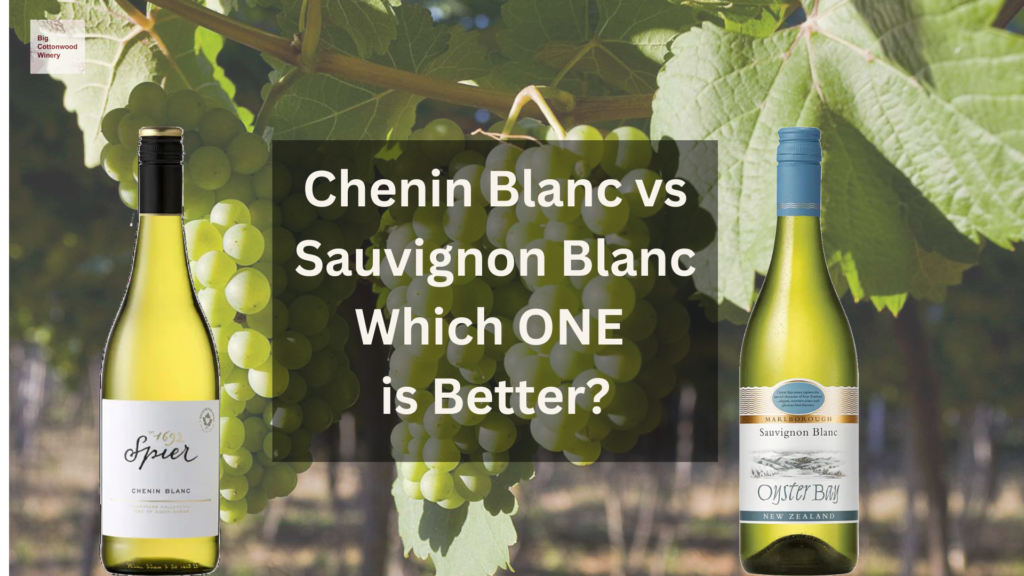
10. Conclusion
As we approach the conclusion of the comparison of Chenin Blanc and Sauvignon Blanc, it is obvious that these two white wine varietals provide a fascinating contrast. We believe that wine lovers have a wide variety of options since each wine brings to the glass its distinct personality, tastes, and qualities. I hope this post Chenin Blanc vs. Sauvignon Blanc may provide you with more information about these two well-known white wines and help you choose the most suitable wine!

In 2014, Leo Colon began working with Big Cottonwood Winery. Over the years he has remained part of this prestigious winery’s team and is also a contributor to other notable wine publications. As an ardent advocate for knowledge, Leo continues his vinous education to this day.
